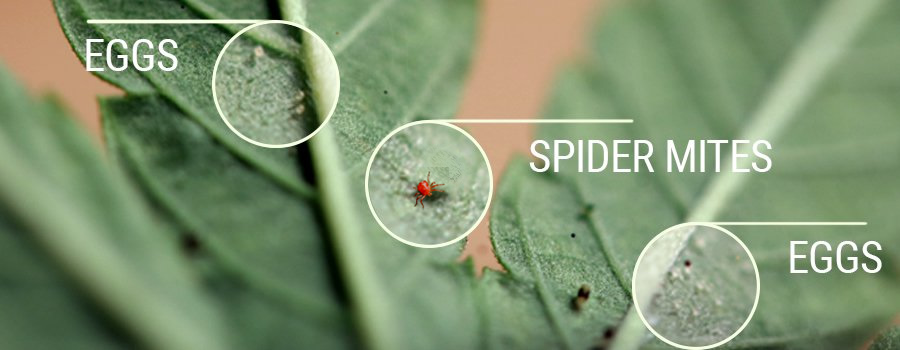How to Get Rid of Spider Mites
- Jonathan Valencia

- Aug 9, 2021
- 5 min read
Updated: Oct 9
Spider mites are small bugs that will suck your plants dry. They can quickly become a problem for any indoor gardener. Warm, dry temperatures create the perfect climate for the spider mite’s reproductive cycle. These small bugs can overrun your farm and suck the life out of your plants in no time flat.

Identifying Spider Mites
The best way to identify these critters is to look under the leaves of your plants. There are basically 2 types of spider mites. The first type is small and black. The second type is red with black spots.
They lay eggs after they mature which is usually about 2 weeks after hatching. A female can lay thousands of eggs over their lifetime. Eggs hatch in about 3 days.
Once the spider mites have appeared in your indoor garden, they can multiply very quickly. So you must move fast.
If you find that you have a spider mite infestation on your hands, then find the plant or plants that have the most damage and isolate that plant from the rest of your system. This can help you to quickly gain control of the pests that have infiltrated your farm or garden.
How to Stop Spider Mites Before They Start
Check 'Em Out First: Before you bring any new plant home, give it a good look-over. Check under the leaves and along the stems for any tiny specks or weird webbing. It's better to be safe than sorry!
Keep Your Plants Happy: Just like people, healthy plants are better at fighting off problems. Make sure your plants are getting enough water and food (fertilizer) so they can stay strong and resist pests.
Clean Up Your Act: Pests love hiding in messes. Keep your garden beds and pots tidy by pulling weeds and clearing out old leaves and debris. Less clutter means fewer places for spider mites to hang out.
Give Them a Spa Day: Spider mites hate humidity and love dry air. You can make your plants less appealing to them by misting the leaves with water or using a humidifier nearby.
Start with Good Soil: Use a clean, high-quality potting mix. This helps prevent any creepy-crawlies from hitching a ride in the dirt and getting a head start on your plants.

How to Recognize the Presence of Spider Mites
In cool climates, spider mites overwinter as eggs and hatch in spring; but in warmer climates, they can feed on plants year-round. Emerging larvae become mature adults in just 1-2 weeks, building colonies on the underside of leaves.
Several generations occur throughout the growing season, though they can live year-round indoors. Their populations multiply rapidly as the weather warms, becoming most prevalent during summer when conditions are hot and dry.
Inspect plants:
Check plants regularly to identify any pests or diseases, as much as twice a week during drought conditions when spider mites thrive. It’s important to discern whether problems are due to insect damage, disease, nutritional deficiency or cultural practices before determining a course of action.
Know the signs:
Since spider mites are tough to spot with the naked eye, look for telltale signs of their activity. One indication is the presence of fine webbing, particularly on the underside of leaves and at branch intersections.
Take a closer look:
Inspect the underside of affected leaves with a magnifier to see if you can spot them. Hold a piece of white paper underneath the leaves and gently tap the plant to shake bugs loose. Spider mites will be easier to see against the light-colored backdrop.
How to Get Rid of Spider Mites
Spray with water:
Use a nozzle attached to a garden hose and create a gentle water spray to dislodge webbing and as many insects as possible. Make sure to get the undersides of the leaves. This also removes dust from the leaves, a favorite hiding spot for mites.
controls a wide range of fungal diseases, as well as aphids, Japanese beetles, spider mites, whiteflies, caterpillars and other listed insects. Can be used up to day before harvest.
is another possibility for getting rid of spider mites. This works by penetrating and clogging body membranes. Ivory liquid dish soap, Castile soap, and Murphy’s Oil soap are soft soaps that will work but they are not as potent or effective as commercial insecticidal soaps.
Homemade remedies:
You can make your own insecticidal soap. Use a mild liquid soap such as Castile or Ivory and mix 1 tablespoon into 1 quart of water. Apply with a spray bottle. Other home remedies include garlic, pepper (capsaicin), peppermint or rosemary.
A natural extract of the neem tree, neem oil is a general pest repellent that will smother spider mites upon application. This is a longer-lasting solution, and is often used after applying an insecticidal soap. Use as directed and keep away from pets and children.
Use other bugs:
Beneficial insects that prey on spider mites offer natural pest control. These include lady bugs, predatory mites, lacewings and spider mite destroyers. These insects are harmless to people, pets and plants. This solution is most effective if you are able to get the good bugs as eggs (adults will generally just fly away).
Extra measures:
If an infestation becomes severe, remove the most affected leaves, place them in a sealed plastic bag and dispose in the garbage. Don’t put them in the compost, as this can spread the problem. In extreme cases, an entire plant may need to be removed.
Avoid chemicals:
Chemical pesticides can upset the ecological balance. This can allow other predatory pests to move in and cause secondary problems.
Of course, prevention is the best answer. Keeping the grow room clean and sanitary will help to keep harmful bug populations under control. Being aware of any bugs in your garden can also be very helpful in preventing infestations.
Taking the time out every few days to examine your plants carefully will help you to identify potential bug infestations BEFORE they happen.
As a preventative measure when growing indoors, I usually spray or dip the plants in a neem oil solution just before the start of their vegetative cycle. Then about 3-6wks later just after the flowering cycle begins I will usually spray again. This usually is enough to prevent bugs from appearing until harvest time.
As I’ve mentioned before, there is no substitute for vigilance. Take the time to care for your plants’ needs and you’ll be rewarded with a great harvest.
Many people have also come up with their own homemade recipes.
How to Prevent Spread on Uninfected Plants:
Quarantine:
Keep new houseplants away from other plants for 30-40 days to prevent possible spread of spider mites.
Keep it humid:
Spider mites thrive in dry conditions. Boost room humidity, particularly in winter when household air is dry. Use a room humidifier or regularly mist plants with a spray bottle. Another alternative is to place plants on trays filled with pebbles and a small amount of water. Don’t allow the bottom of the pot to sit in standing water.
Clean leaves:
Wipe leaves regularly with a damp cloth to remove and deter pests.
Remove pests:
Spray affected plants with insecticidal soap or use a cotton swab dipped in diluted 70% rubbing alcohol to kill visible pests.
Use neem oil cautiously:
If applying neem oil, take care not to get the oil on clothing, furniture or other household items.
Happy Growing!































Comments